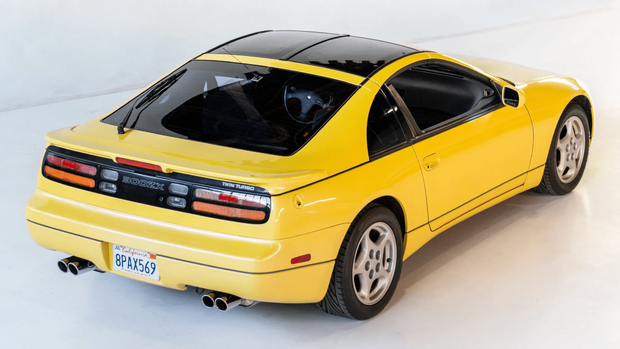Why some cars from the 1990s are soaring in value
Not that long ago, cars from the 1990s were just used cars. And, really, most of them still are, if they're still running at all. But as millenials get older, gain some disposable income, and pine for the cars of their own youth, many of these cars have crossed the threshold to becoming sought after collectibles with rising values in the car collecting world.
Cars from brands like Ferrari, Bugatti and McLaren are, of course, highly valued, but some models from manufacturers like Toyota, Mitsubishi and Volkswagen have also seen their values soar.
"Values, for the last three years, for cars and vehicles from the 1990s have increased the most out of any decade," said Brian Rabold, vice president of automotive intelligence at Hagerty, a company that closely tracks the collector car market. In addition to insuring collectible cars, Hagerty also owns the auction company Broad Arrow.
Values for 1990s-era collectible cars have risen by an average of 78% over the past three years, "which is huge," Rabold said.
Several factors are ramping up the interest level, Rabold and others said. First, there is the simple passage of time. Twenty-five years, give or take, marks the time when some special cars become collectible. For one thing, depreciation has run its course.
Usually, even if their condition remains largely the same, cars become less and less valuable with each passing year, but only up to a point.
Then some cars, ones that are special and desirable for whatever reason, begin to increase in value. That's because, as the cars have been getting older, so have the people who were teenagers or maybe in their early twenties when these models first came out. They may have wanted them back then, but couldn't afford them. Now they've grown up and have the disposable income to buy that Mitsubishi 3000GT, say, just for fun.
Collectors are often attracted cars outside their own age range, too, said Randy Nonnenberg, co-founder and president of the online collector car auction site Bring a Trailer.
"We have young people that like 70 year old cars, and we have an 80 year old guy who just bought a new [Porsche 911] GT3," he said. "So, I mean, it's all over the map."
Also, the end of the 20th century and the beginning of the 21st marked a turning point in automobiles themselves.
"A lot of people think of the golden age of the automobile was the '50s and '60s," said Eric Charnholm, who owns a 1992 Nissan Sentra SE-R, a car he spent 15 years looking for. "There's an argument to be made that the '90s is actually the golden age."
In that era, automakers figured out how to make small cars that met fuel economy requirements, but that could also be fun to drive.
"You had this mix of high horsepower, light weight with minimal safety systems that made them for a very fun combination," he said.
Cars of the 1990s still had a somewhat raw, mechanical feel that is often lost in modern cars replete with computer assisted and drive-by-wire technology, where cables, computers and actuators, rather than just gears and hydraulics, make the connection between the driver and the road, said Nonnenberg.
"Modern cars are very comfortable and wonderful," he said, "but it's more of a sort of ride-along experience."
Still, cars from the 1990s are far from ancient, unlike models from the early 20th century which have, on average, fallen in value in recent years, according to Hagerty. Cars from the '90s have at least some modern comfort and safety features, and even relatively inexpensive cars can have respectable power and performance.
"They have air conditioning, they have power windows, they have airbags, a lot of them," he said, "but they have a little more character."
None of this means that all cars from the 1990s are going up in value. We're talking about "collectible" cars. These are usually, but not always, sports cars or performance models. With some exceptions, like '90s Buick Roadmasters wagons, practical family cars are not generally considered collectible. (Prices for Roadmaster wagons have increased 48% since 2019, according to Hagerty.) Just as in the new car market, pickups and SUVs are now finding fans, too, but not everyone gets the appeal.
"Mid-nineties pickup trucks are the ones that make me scratch my head," said Frank Mecum, consignment director for Mecum Auctions. "We're selling some of these low-mileage pickup trucks for fifty, sixty, seventy grand and they're just normal pickup trucks."
Between 2015 and 2018, buyers paid an average of $13,375 for 1990s Ford Broncos on Bring a Trailer. Now those Broncos are going for almost double that amount. Prices for Volkswagen Vanagons, a more modern version of the VW Bus, have similarly increased, according to the auction site. Toyota Land Cruisers have are also sought after.
"We're big fans of the Land Cruisers in general, but that specific generation, the early '90s to '97, is kind of a favorite," said Mike Marzano, who owns Mouse Motors, a company that deals in collectible vehicles. "I guess it's practical in the sense that it's, you know, a family hauler, but they're not very fuel efficient. They're actually awful."
The 1990s were also an era when there were a lot of appealing Japanese sports cars, thanks to that country's economic boom in the 1980s. Robert Yeager, author of the book "The NextGen Guide to Car Collecting," owns a 1996 Lexus SC 300. He loves the car for its design and it's exciting to drive, he said.
"I think the '90s are really a sweet spot for people who are looking for cars that are fun." he added.
Even inexpensive Japanese cars of that era boasted quality that wasn't matched by American automakers at the time, he said.
Values for the early '90s Mitsubishi Eclipse have risen 40% since 2020 while prices for the closely the closely related Eagle Talon, a product of Mitsubishi and Chrysler, have risen almost 45%, according to Hagerty.
Values for Nissan 300ZX models and '90s Mazda Miatas are also rising, according to Bring a Trailer. But they remain fairly affordable with early '90s Miatas going for about $14,000 and Nissan ZXs for about $26,000 on the site.
Radwood, a series of car meet-ups for 1980s and '90s cars, started in California and has now spread into a series of events around the country. Radwood has become a full time job for co-founder Art Cervantes who owns 1998 BMW M3 and a 1987 BMW 325is. The Radwood event series, which has its own line of branded merchandise, is now owned and operated by Hagerty.
Cervantes also recently purchased a 1996 Nissan Skyline GT-R, a model better known as, simply, the GT-R in the United States. His purchase of the GT-R touches on another reason cars can become collectible after 25 years. The GT-R wasn't available in the US in 1996, but regulations allow for cars that couldn't be owned here when new to be freely imported and driven after after 25 years.
"I bought this car in March of 2022," he said, "and it's appreciated approximately $20,000 since I bought it based on how the market is going."
For many of their owners these cars aren't just for show of for weekend jaunts. While still being desirable and collectible, they can function as vehicles for daily use.
These cars aren't so old and delicate that using them as a primary form of transportation is out of the question, said Bring a Trailer's Nonnenberg.
"There's some people that even want that for their everyday sort of car, right?" he said. "They're not as interested in driving the Tesla, they'd rather drive car from the 90s or the 2000s."




